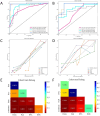Integrated radiomics and deep learning model for identifying medullary sponge kidney stones
- PMID: 40786086
- PMCID: PMC12331667
- DOI: 10.3389/fmed.2025.1623850
Integrated radiomics and deep learning model for identifying medullary sponge kidney stones
Abstract
Background: Medullary sponge kidney (MSK) is a rare congenital anomaly frequently associated with nephrolithiasis. Accurate preoperative differentiation between MSK stones and non-MSK multiple kidney stones remains challenging, yet it is essential for effective clinical decision-making. This study aims to develop a novel diagnostic model that integrates radiomics and deep learning features to improve the differentiation of MSK stones using CT imaging.
Methods: This single-center, retrospective study included patients who underwent surgical treatment for multiple kidney stones at Beijing Tsinghua Changgung Hospital between 2021 and 2023. All MSK and non-MSK cases were confirmed via endoscopic surgery. Radiomics features were extracted from manually delineated regions of interest (ROI) on nephrographic-phase CT images, while deep learning features were derived from a ResNet101-based model. Three diagnostic signatures-Radiomics (Rad), Deep Transfer Learning (DTL), and Deep Learning Radiomics (DLR)-were developed. A Combined model was constructed by integrating clinical variables with DLR features to further enhance diagnostic accuracy. Model performance was evaluated using AUC, calibration curves, Net Reclassification Index (NRI), and Integrated Discrimination Improvement (IDI) analyses. Additionally, Gradient-weighted Class Activation Mapping (Grad-CAM) visualization was employed to identify imaging regions critical to classification, improving interpretability.
Results: A total of 73 patients with multiple kidney stones were analyzed, comprising 34 MSK cases and 39 non-MSK cases, encompassing 110 kidneys in total. The DLR signature demonstrated high diagnostic accuracy, with AUCs of 0.96 in both the training and test cohorts. The Combined model further enhanced diagnostic performance, achieving AUCs of 0.98 in the training cohort and 0.95 in the test cohort. Calibration curves indicated strong agreement between predicted probabilities and observed outcomes. Furthermore, NRI and IDI analyses highlighted the superior predictive power of both the DLR and Combined models compared to other approaches.
Conclusion: This study introduces an innovative approach for MSK stone diagnosis by integrating radiomics and deep learning features. The proposed model offers high diagnostic accuracy and promising clinical utility.
Keywords: artificial intelligence; deep learning; kidney stone; medullary sponge kidney; radiomics.
Copyright © 2025 Liu, Song, Luo, Xu, Xu, Wang, Hu, Xiao, Zhang and Li.
Conflict of interest statement
The authors declare that the research was conducted in the absence of any commercial or financial relationships that could be construed as a potential conflict of interest.
Figures




Similar articles
-
Multilayer perceptron deep learning radiomics model based on Gd-BOPTA MRI to identify vessels encapsulating tumor clusters in hepatocellular carcinoma: a multi-center study.Cancer Imaging. 2025 Jul 7;25(1):87. doi: 10.1186/s40644-025-00895-9. Cancer Imaging. 2025. PMID: 40624579 Free PMC article.
-
Deep learning radiomics nomogram for preoperatively identifying moderate-to-severe chronic cholangitis in children with pancreaticobiliary maljunction: a multicenter study.BMC Med Imaging. 2025 Feb 5;25(1):40. doi: 10.1186/s12880-025-01579-3. BMC Med Imaging. 2025. PMID: 39910477 Free PMC article.
-
Integrative radiomics of intra- and peri-tumoral features for enhanced risk prediction in thymic tumors: a multimodal analysis of tumor microenvironment contributions.BMC Med Imaging. 2025 Jul 17;25(1):286. doi: 10.1186/s12880-025-01790-2. BMC Med Imaging. 2025. PMID: 40676529 Free PMC article.
-
Management of urinary stones by experts in stone disease (ESD 2025).Arch Ital Urol Androl. 2025 Jun 30;97(2):14085. doi: 10.4081/aiua.2025.14085. Epub 2025 Jun 30. Arch Ital Urol Androl. 2025. PMID: 40583613 Review.
-
Artificial intelligence for diagnosing exudative age-related macular degeneration.Cochrane Database Syst Rev. 2024 Oct 17;10(10):CD015522. doi: 10.1002/14651858.CD015522.pub2. Cochrane Database Syst Rev. 2024. PMID: 39417312
References
LinkOut - more resources
Full Text Sources

